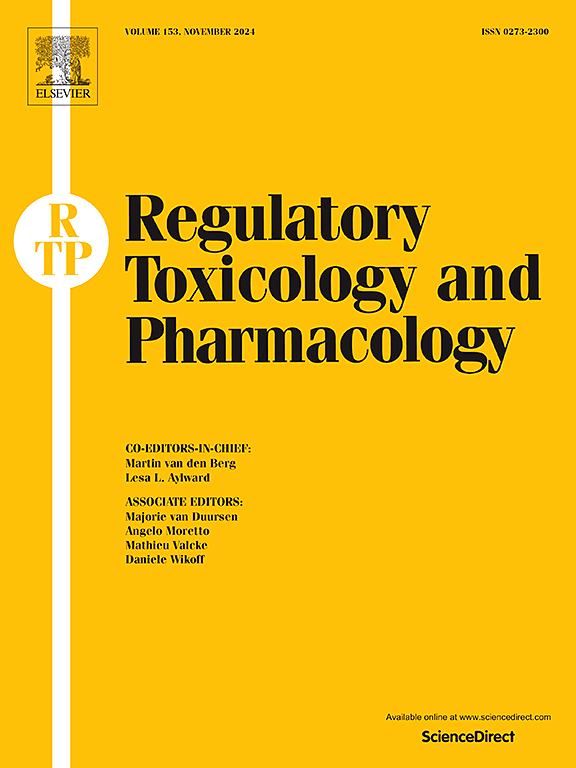Preclinical safety studies of a SEDDS formulation of the vasorelaxing methanol extract from Crataegus rosei eggl. Leaves
IF 3
4区 医学
Q1 MEDICINE, LEGAL
引用次数: 0
Abstract
The present study aimed to assess, via acute and subacute toxicity studies, the safety of the use of the methanol extract obtained from Crataegus rosei leaves as a self-emulsifying drug delivery system (Cr-SEDDS). For the acute toxicity test, female rats were intragastrically administered single 300 and 2000 mg/kg body weight (bw) doses and followed by an observation period of 14 days. For the subacute toxicity study, female and male rats received a daily 300, 500, and 1000 mg/kg bw dose for 28 days. No decrease in food consumption, body weight, signs of apparent toxicity, or deaths were observed. Macro and microscopic necropsies were performed on the main organs, as were blood chemistry, lipidic parameters, and biometry studies. No significant differences in the levels of liver and kidney biomarkers, the levels of red and white blood cells, or structural alterations were observed in the organs of both the treated and control groups. Therefore, the results of these studies demonstrated that the Cr-SEDDS is non-toxic at repeated doses of up to 1000 mg/kg bw. These data enable the establishment of safe dose levels necessary to continue with in vivo pharmacological studies of this SEDDS for the subsequent development of a phytomedicine for the treatment of cardiovascular diseases.

玫瑰山楂血管舒张甲醇提取物SEDDS配方的临床前安全性研究。叶子。
本研究旨在通过急性和亚急性毒性研究,评估将山楂叶甲醇提取物用作自乳化给药系统(Cr-SEDDS)的安全性。在急性毒性试验中,给雌性大鼠胃内注射单剂量 300 毫克/千克体重(体重)和 2000 毫克/千克体重(体重)的药物,然后观察 14 天。在亚急性毒性研究中,雌性和雄性大鼠每天按每公斤体重 300、500 和 1000 毫克的剂量服药,共服药 28 天。未观察到大鼠的食量、体重、明显中毒症状或死亡。对主要器官进行了宏观和显微尸体解剖,并进行了血液化学、脂质参数和生物测量研究。处理组和对照组的肝脏和肾脏生物标志物水平、红细胞和白细胞水平以及器官结构变化均未发现明显差异。因此,这些研究结果表明,重复剂量达到 1000 毫克/千克体重时,SEDDS 中的铬是无毒的。这些数据有助于确定必要的安全剂量水平,以便继续对这种 SEDDS 进行体内药理学研究,从而开发出治疗心血管疾病的植物药。
本文章由计算机程序翻译,如有差异,请以英文原文为准。
求助全文
约1分钟内获得全文
求助全文
来源期刊
CiteScore
6.70
自引率
8.80%
发文量
147
审稿时长
58 days
期刊介绍:
Regulatory Toxicology and Pharmacology publishes peer reviewed articles that involve the generation, evaluation, and interpretation of experimental animal and human data that are of direct importance and relevance for regulatory authorities with respect to toxicological and pharmacological regulations in society. All peer-reviewed articles that are published should be devoted to improve the protection of human health and environment. Reviews and discussions are welcomed that address legal and/or regulatory decisions with respect to risk assessment and management of toxicological and pharmacological compounds on a scientific basis. It addresses an international readership of scientists, risk assessors and managers, and other professionals active in the field of human and environmental health.
Types of peer-reviewed articles published:
-Original research articles of relevance for regulatory aspects covering aspects including, but not limited to:
1.Factors influencing human sensitivity
2.Exposure science related to risk assessment
3.Alternative toxicological test methods
4.Frameworks for evaluation and integration of data in regulatory evaluations
5.Harmonization across regulatory agencies
6.Read-across methods and evaluations
-Contemporary Reviews on policy related Research issues
-Letters to the Editor
-Guest Editorials (by Invitation)

 求助内容:
求助内容: 应助结果提醒方式:
应助结果提醒方式:


